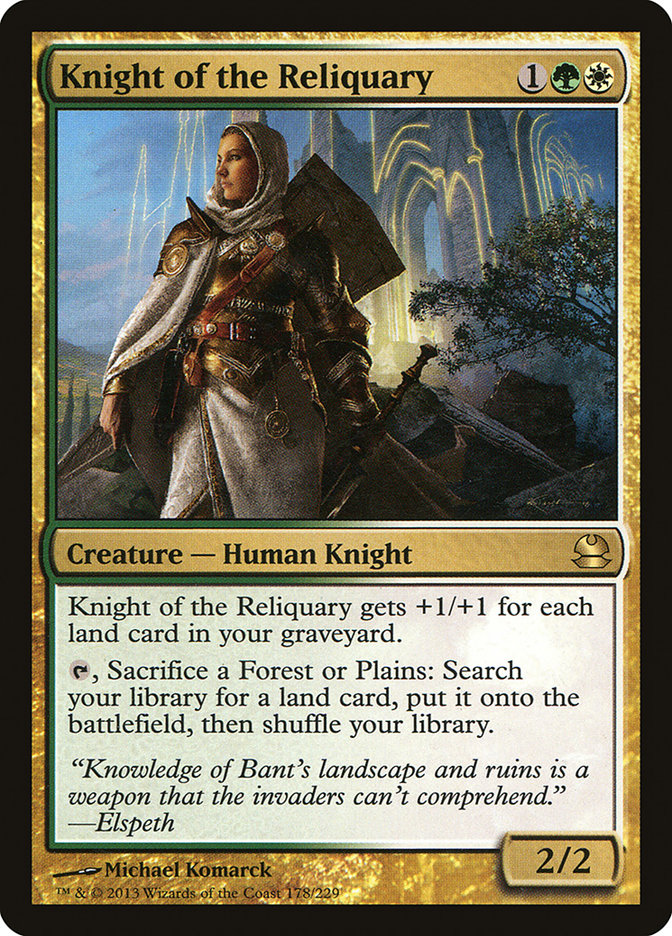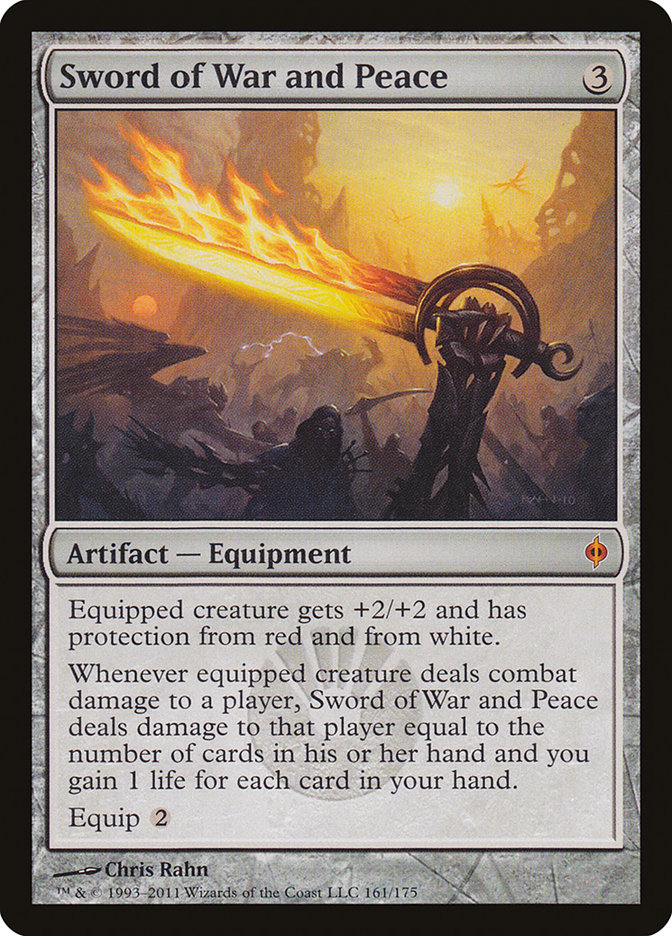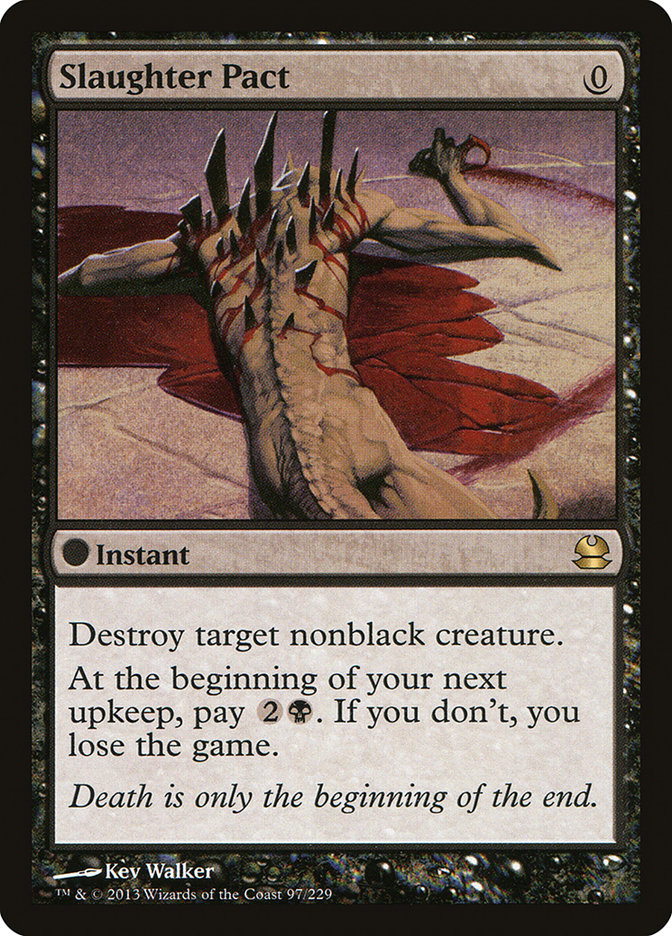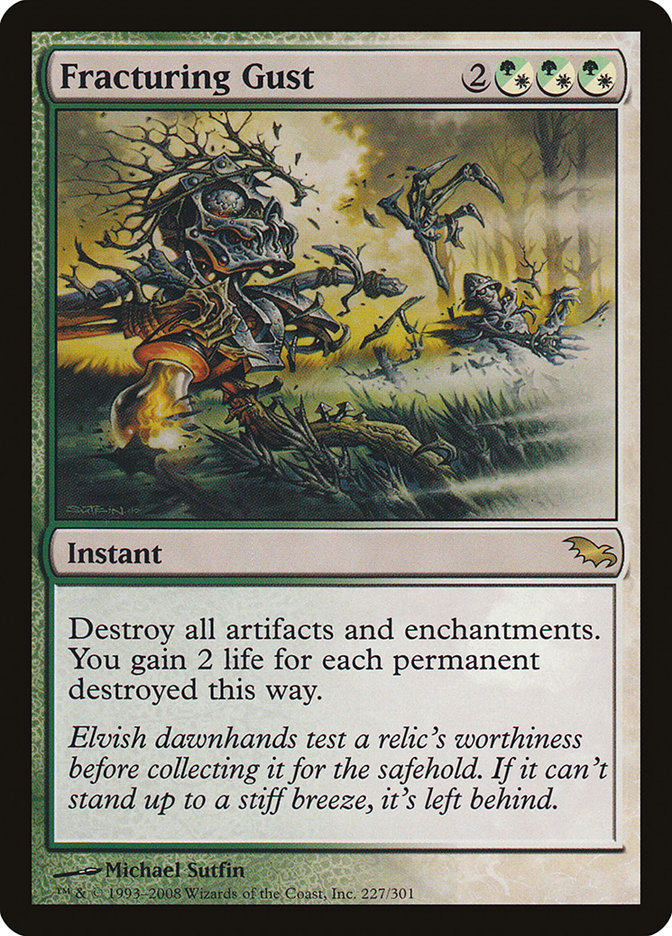Modern is a strange format to prepare for. On the one hand, the card pool doesn’t rotate, and new sets are unlikely to have a huge impact because of the
overall power level. This means that the accumulated knowledge from past years of testing retains value. On the other hand, the size of the format means
that it’s nearly impossible to test against everything you may run into over the course of a tournament. Even if you can perfectly predict the most popular
decks in the metagame, you could easily go an entire tournament without ever playing against any of them.
After the banned list announcement axed Treasure Cruise, Dig Through Time, and Birthing Pod, it was abundantly clear that the top deck at the Pro Tour
would be Abzan Midrange. Decks built from the shell of Thoughtseize, Tarmogoyf, and Liliana of the Veil have been staples of the Modern format for years.
The blue delve card-drawing effects and Birthing Pod had been among the best ways to beat discard-based disruption, and with those gone and Siege Rhino now
in the mix, Abzan was the obvious go-to deck. Abzan was also the recipient of one of the few Modern power level cards in Fate Reforged with Tasigur, the Golden Fang, a factor that only served to increase its likely popularity.
This was reflected in Magic Online results leading up to the Pro Tour. While it’s easy to overstate the significance of Magic Online daily event decklists,
since they’re frequently biased toward inexpensive decks, they do offer a reasonable barometer for the metagame. This is especially true in a format like
Modern where the availability of cards from the new set is unlikely to make a huge impact. The Magic Online Modern daily event lists leading up to the Pro
Tour had two decks that were far and away more popular than the rest: Abzan and Burn.
The popularity of aggressive red decks on Magic Online is often far greater than in the real world, since they’re among the cheapest decks to build and
they finish games quickly, making them an optimal choice for someone looking to grind out tickets and packs with a low investment. In this case though, I
was pretty sure it was the real deal. Not only is Modern Burn not exactly a budget deck, thanks to the cost of fetchlands and the like, but it’s also an
excellent deck against the presumptive metagame leader in Abzan. If people are fetching for shocklands and Thoughtseizing you, you’re really happy to show
them a fist full of Lava Spikes. Burn wasn’t just a Magic Online metagame deck–it was a real contender that had to be taken seriously. I came into testing
solidly certain that Abzan would be the most played deck, with a suspicion that Burn would be more popular than most people expected.
Since Modern is a format with a relevant history, I thought back to the last time the metagame looked similar. At Pro Tour Return to Ravnica, Jund was
everywhere, making up nearly a third of the field at that event and not really losing any steam even in the wake of Stanislav Cifka winning the tournament
with Eggs. To combat the Thoughtseize/Liliana-heavy field, I built a G/W aggro deck packed with anti-discard and sacrifice effects like Loxodon Smiter,
Wilt-Leaf Liege, and Lingering Souls that I played to a Top 16 finish at Grand Prix Chicago in 2013.
Creatures (28)
- 4 Birds of Paradise
- 2 Aven Mindcensor
- 1 Gaddock Teeg
- 4 Wilt-Leaf Liege
- 4 Noble Hierarch
- 3 Qasali Pridemage
- 2 Baneslayer Angel
- 2 Linvala, Keeper of Silence
- 2 Thalia, Guardian of Thraben
- 4 Loxodon Smiter
Lands (23)
Spells (9)

While today’s bogeyman is Abzan rather than Jund, the core of the deck is still the same: discard, Liliana, and removal to pick apart the opponent’s
gameplan and grind out wins. Those cards are downright embarrassing against Wilt-Leaf Liege and friends, so I felt like the same shell was a good place to
start in today’s format. In a world of Lilianas, Lingering Souls is king, and Gavony Township and Wilt-Leaf Liege are the best support Lingering Souls can
ask for.
This Pro Tour was the first time that my usual testing team – CFB Prime, including LSV, Wrapter, EFro, PV, Ochoa, etc – linked up with Team Face to Face
for our preparation. Interestingly, they had come to some of the same conclusions that I had about the format from a totally different starting point. Sam
Pardee and Josh Mcclain were both recovering Birthing Pod addicts and were exploring ways to build “Podless Pod.” They were trying different ways to use
the same base of value creatures, Lingering Souls, and Gavony Townships that Birthing Pod decks typically sideboarded into in order to combat Abzan. As a
result, our initial shells we brought to the table looked very similar and gave us a common ground to work from on a deck.
The big differences between our initial lists were evidence of their origins. Their first builds included a bunch of Pod-style value creatures like Kitchen
Finks, Restoration Angels, and even Thragtusk, while mine were focused on aggression with Loxodon Smiter and Wilt-Leaf Liege. We experimented with a
variety of different configurations, but ultimately moved more in the direction of actually killing our opponents. With both Voice of Resurgence and
Lingering Souls in the mix, along with Gavony Township, the deck wasn’t really lacking in ways to win longer attrition-based games but didn’t have all that
much disruption against combo. We found the best way to win was just putting them on as fast a clock as possible, something which Wilf-Leaf Liege and Siege
Rhino each contribute to significantly. Both have the ability to advance your clock the turn you play them without needing to ever attack themselves, which
is a characteristic that is frequently missing from a green creature deck without red.
Perhaps the strangest part of our testing process came when the Face to Face guys were experimenting with Knight of the Reliquary as one of the deck’s
three-drops. I found myself in the bizarre position of actually arguing against playing my favorite card in all of Magic. My contention was that
Loxodon Smiter’s combination of a guaranteed 4/4 body for three and immunity to countermagic and discard was more important in the metagame than the higher
objective power level of Knight. The difference between Knight and Smiter against decks with Remand is absolutely huge, since Smiter is virtually a Time
Walk when your opponent leaves open mana to counter your play and you drop an elephant. I also knew that I wanted to play multiple copies of Razorverge
Thicket along with a lot of basic lands to provide a relatively painless manabase against Burn, and I didn’t like playing Knight against decks with three
damage burn spells with fewer than eleven or so fetchlands, so the math just didn’t work out. Knight also makes Scavenging Ooze better against you and
makes it more difficult to use cards like Relic of Progenitus in the sideboard yourself. It pained me to leave Knight of the Reliquary on the sidelines,
but I’m certain the decision was correct.
Qasali Pridemage was also a somewhat contentious inclusion, and I’m not nearly as sure that it belongs as I am that Knight does not. Voice is the clear
best two-drop, since it’s so good against Liliana, forces your opponents into awkward lines of play on their own turn, and represents a huge threat thanks
to Lingering Souls and Wilt-Leaf Liege. After Voice, the options get a lot worse.
Scavenging Ooze has some appeal, but without much discard and with Path to Exile as the only removal in the deck, you have to rely on combat to actually
get creatures into the graveyard, which can make it pretty underwhelming at times. Similarly, Tarmogoyf just doesn’t have enough support to actually get
big quickly in the early turns of the game without Lightning Bolt or Thoughtseize to actually get cards into the graveyard. Pridemage isn’t incredible in
most matchups, but exalted comes in handy quite often, and the G/W body obviously works very well with Liege. Having access to some artifact and
enchantment removal in game 1 also gives you outs to things like Splinter Twin or Cranial Plating that could otherwise end the game. Pridemage may not be a
superstar, but it’s a solid role-player that helps cover a lot of bases and gives you something to play early when you may not have a mana creature.
Here is the deck I played in the Pro Tour. Jacob Wilson, Josh Mcclain, Sam Pardee, and Jon Stern all played nearly identical lists, with at most a card or
two in the maindeck and sideboard different.
Creatures (27)
- 4 Birds of Paradise
- 2 Kitchen Finks
- 3 Wilt-Leaf Liege
- 4 Noble Hierarch
- 2 Qasali Pridemage
- 4 Loxodon Smiter
- 4 Voice of Resurgence
- 4 Siege Rhino
Lands (23)
Spells (10)

For most of our testing, we actually didn’t have any disruption outside of removal and Qasali Pridemage in the maindeck, focusing instead on presenting as
many strong, resilient threats as possible. The reasoning behind this is that it’s important for a deck playing with a lot of mana accelerants to have as
many proactive threats as possible, or else you risk drawing hands full of acceleration with nothing to actually play. When your deck has over thirty mana
sources, you can’t afford to dilute it with a lot of reactive cards because you’re that much more vulnerable to flooding out. Gavony Township and Wilt-Leaf
Liege both go a long way toward making your mana accelerants into actual threats, but you can’t afford to fill your deck with discard and removal like a
traditional G/B deck if you’re playing a bunch of Birds and Hierarchs.
Ultimately, we ended up playing two copies of Thoughtseize in our maindeck alongside four Path to Exile. Path is just the best removal option available
when you’re worried about cards like Siege Rhino and Tasigur. I used to like a split of Path and Dismember when Dark Confidant was popular, because I
wanted to kill the Confidant immediately and not have to give my opponent a land, but without Confidant around and with a lot of Burn in the metagame, Path
is a much more appealing option. Thoughtseize can help clear out removal to make way for your actual threats, so it’s semi-proactive in a way that a card
like Abrupt Decay is not, and playing some of them in the maindeck helped free up some space in the sideboard. Modern is a format in which sideboard slots
are inordinately valuable, since there are so many powerful linear strategies like Affinity, Storm, and Burn that can be difficult to interact with outside
of targeted sideboard cards. We knew we wanted access to four copies of Thoughtseize after sideboarding against a lot of different decks, so moving two of
them to the maindeck gave us more room for backbreaking cards like Rule of Law, Stony Silence, and Leyline of Sanctity.
We chose to play Chalice of the Void as something of a hedge against three different linear decks: Storm, Burn, and Infect. It isn’t the best card against
any of them, but it is serviceable against all of them by shutting down quite a few of their key spells. A Chalice on one turns off most of Storm’s card
selection spells, while a Chalice on two keeps them from playing Pyromancer Ascension, Echoing Truth, Grapeshot, or any of their rituals. The latter is
more powerful there, but if you don’t have the time to get to four mana, the former can be a good stopgap. Chalice on one also shuts down a huge swath of
the best spells in Burn and pump spells in Infect. It does little against Become Immense, however, and Wild Defiance still triggers even if the spell is
countered, so it may not be the best choice against the newer versions of Infect.
Sword of War and Peace was similarly a card with crossover value against both Jeskai Control decks and Burn. It’s one of the best possible cards against a
control deck relying on Lightning Bolt and Path to Exile for removal, since it turns each of your creatures into a huge threat that can’t be removed
outside of a wrath effect. Against Burn, it’s a little slow, but even a single hit can swing the race enough in your favor to decide a game. We anticipated
that Jeskai would be more popular than it ended up being, so this is definitely a card that can potentially be replaced to shore up other matchups. It does
have nice crossover value against decks like W/B Tokens or Soul Sisters, but those are such small segments of the field that they’re not worth sacrificing
percentage against more common decks to get an edge on.
Similarly, Ajani, Mentor of Heroes was a card that was aimed at control and midrange decks like Jeskai and Azban. Five is a lot of mana, but Ajani is
extremely difficult for many decks to beat if you play it on anything close to an even board. Both +1 abilities generate significant advantages every turn,
either digging up additional threats or making what you already have on the board more powerful. We considered playing Sorin, Solemn Visitor either in
addition or in place of Ajani, since it is also powerful in attrition games while having the added bonus of potentially generating huge life swings against
Burn. We ended up playing Ajani because it was stronger against control decks where we felt like we wanted more help, but in the actual Pro Tour metagame,
Sorin would have almost certainly been better.
Slaughter Pact and Abrupt Decay offered a little extra removal in matchups where that was important. I had two copies of Slaughter Pact for a while, since
it’s so good against Splinter Twin decks that are sticking with the combo plan after sideboarding, but the fact that Abrupt Decay could kill Cranial
Plating or an early Steel Overseer against Affinity helped move the needle in its favor. As I mentioned before, sideboard slots are so valuable in Modern
that it’s important to get overlap value where you can.
Speaking of which, Fracturing Gust was an attempt to get value against both Affinity and Hexproof from the same card. Creeping Corrosion and Stony Silence
are better against the all-artifact deck clearly, but Fracturing Gust isn’t too much worse while also serving as a haymaker against the enchantment-laden
Hexproof deck. With eight mana accelerants in your deck, Gust is easy enough to cast early on and can even wipe out activated Inkmoth and Blinkmoth Nexuses
since you can play it as an instant. My Fracturing Gusts in Valencia last year are the only reason I had a hope against the Hexproof opponent I did face.
If I knew for certain that no one would show up with Slippery Bogles, I’d be happy to just play anti-artifact cards, but it’s better to be safe than sorry.
That’s the same reason I played a singleton Relic of Progenitus. With the unbanning of Golgari Grave-Troll and prominence of delve, it seemed likely that
we’d see people playing some kind of graveyard decks at the Pro Tour, and I wanted to have some way to interact with them. Relic is nice because it’s
flexible enough to have value even against decks that aren’t entirely graveyard based, like any deck with Tarmogoyf or Snapcaster Mage. A card that can
give you marginal value against popular decks while potentially being a silver bullet against dedicated graveyard strategies is a great use of a sideboard
slot.
Ultimately, I was very happy with the deck. I finished 7-3 in the Modern rounds, going 2-0 against Abzan, 2-1 against Burn, and beating Tron, Zoo, Infect,
while I lost to Scapeshift and eventual champion Del Morel Leon playing Splinter Twin.
Sadly, a 3-3 record in Draft kept me out of the top spots, and I had to settle for a 59th place finish. I felt like both of my draft decks were good, and I
was happy with my play, but I had some unfortunate draws and matchups. My first deck was a solid but unamazing Temur deck that I piloted to a 2-1 result,
and I thought my second deck was much better, but I only managed to get one win. I won an epic match against Lucas Siow in the first round of the pod but
then had some mana troubles against Ray Tautic to lose the second. In the last round of the pod, I ran into Ivan Floch’s seemingly endless removal spells
backed up by Wingmate Roc and Mob Rule, and fell once again.
You can check out each of my draft decks in the images below
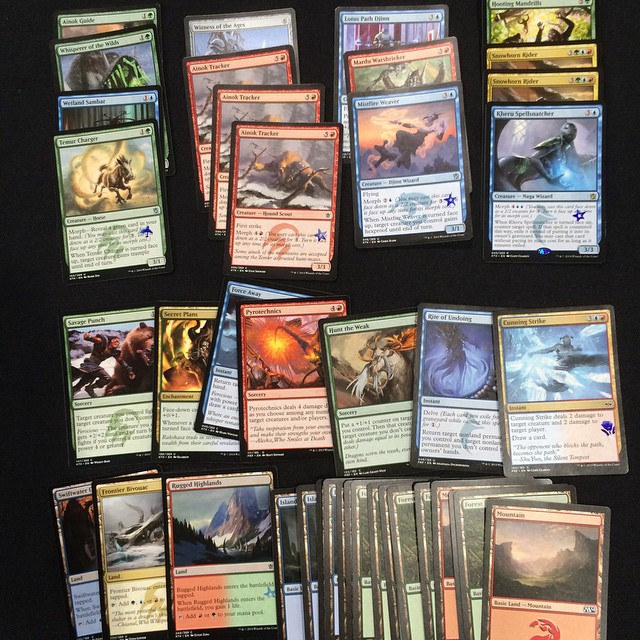
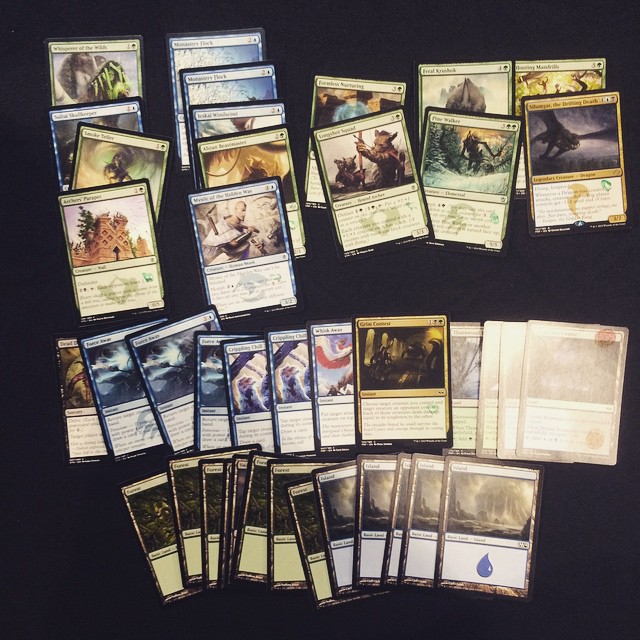
I certainly didn’t come to the Pro Tour hoping to get 59th place, but overall I’m pretty satisfied with how things went. While I didn’t make Top 8 myself,
two members of our testing group did, including Jacob Wilson playing the deck I’d help build. While it’s more fun to be the one winning, it’s still
satisfying to see friends and teammates succeed thanks in part to work you did. Our overall record with the deck was excellent – something like 30-14-1. I
really enjoyed working with the Face to Face guys on the deck, since they were actually on the same page as me and interested in pursuing similar ideas, so
I felt we were able to make a lot of progress. Often I find myself as the only person who’s actually interested in building green creature decks, so I
don’t get nearly as much feedback. Sometimes it’s hard being an honest man who attacks with honest creatures!
I wasn’t planning on going to Grand Prix Vancouver before the weekend, but since I picked up a few extra pro points with my finish, and I already have a
solid deck that I like, I think I’m probably going to make my way up north to Canada to attack with a few more Loxodon Smiters. I’ll certainly be making
some changes in the wake of the Pro Tour, but I think the deck is still fundamentally sound.
I expect Splinter Twin’s victory to keep people playing Abzan, which is Wilt-Leaf Liege’s best matchup. Twin itself is a reasonable matchup already, but I
can certainly see aiming a bit more hate at it after its win this weekend. People wrongly seem to think that Twin is a bad matchup because you don’t have a
full complement of Thoughtseizes and Abrupt Decays maindeck, but the amount of pressure you’re able to put on them early in the game often means that
they’re forced to go off without any kind of protection or die, and sometimes just one Path to Exile is enough. Also, quite often, they just don’t draw the
combo in time, and they just die to your monsters. If you’re looking for more sideboard cards against Twin, I was always a fan of Choke in the matchup
because it’s effective against both the combo and control plans after sideboarding.
If you really want to target Amulet Bloom, you can just play Aven Mindcensor or even Leonin Arbiter and make their life pretty miserable. Much like against
Twin, you actually have a fast enough clock that one Path or Thoughtseize on a Titan can be enough to give you a window to win the game. That’s one of the
great parts of this deck and a major reason I like it over more traditional disruptive Abzan builds. Instead of killing in five attacks with Tarmogoyf, you
can play a turn 1 Hierarch, a turn 2 Loxodon Smiter, and a turn 3 Wilt-Leaf Liege, and kill your opponent on turn 4 with Siege Rhino or another Liege. Yes,
the best Amulet Bloom draws will still beat that, but many will not.
Burn is certain to be popular once again, and while I think the matchup is already a good one, you can certainly add some targeted hate cards to make it
ironclad. I could see playing anything from Leyline of Sanctity to Kor Firewalker to Feed the Clan, as well as the Sorin, Solemn Visitor that I mentioned
earlier. Of these, Leyline is likely the most impactful overall, but Feed the Clan and Sorin each potentially have applications elsewhere.
I don’t expect the Pro Tour results to lead to a rise in Storm, Tron, or Scapeshift decks, which are the matchups that you really don’t want to play
against. Storm matches up very poorly against Burn and Eidolon of the Great Revel, while Tron and Scapeshift are generally weak to Splinter Twin and not
all that great against Burn either.
Overall, it seems like a great time for Wilt-Leaf Liege and friends to come out and play once again…and that’s just what I’m looking for.

